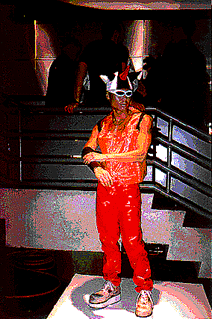
prêt à compute


|
High technology and fashion collided at the MIT Media Laboratory's "Wearables" symposium--a research-meets-fashion/industry event that brought together leaders from international corporations, academic centers, and press agencies. Hosted by Leonard Nimoy (himself a pioneer in the field of the "fashion of the future"), the symposium featured panels focusing on the topics Body Electric, Ready to Ware, Wear Ware where?, and Be Wear; the symposium climaxed in the fashion show Beauty and the Bits, featuring living, fully interactive models on pedestals. According to the visions and prototypes presented by various panelists, our future "Body Electric" might come with the following features: glasses with integrated monitors that project data right into the eye without impeding eye contact (early versions of the glasses were connected to a hat); attachments, such as jewelry, that might measure bodily functions--blood pulse etc.--or give psychological profiles; and circuitry embedded within the fabric of our clothing. (More info at http://wearables.www.media.mit.edu/projects/wearables) Among the jewelry presented was the "heartthrob" (designed by Harry Winston), a brooch worn above the heart that translates the heartbeat of its wearer into the blinking of its ruby-red jewels. For demonstration purposes, Leonard Nimoy kissed the model wearing the brooch--however, the experimental kiss didn't result in excessive flashing of the "heartthrob." The rendering of psychological profiles still seemed to be in its development stage. A video that documented the computerized measuring of the confusion levels of two subjects (a man and a woman) during a lecture, raised the question if the measuring mechanism--based on physical expression--was reliable or if there were significant gender-specific differences in the ways confusion is expressed. At some points during the lecture, the levels of confusion, which were measured in a bar diagram and displayed on a computer screen, seemed to be diametrically opposed: the woman's confusion level went way up while the man's went down to the lowest level. Another prototype designed to redefine what our clothing can do for us is the Musical Jacket. It's an "ordinary" Levi's jacket that was transformed into a musical instrument, complete with keyboard, synthesizer and speakers (http://theremin.media.mit.edu/~levis/jacket.html). As the product info puts it, "If you think that the latest breakthrough in clothing is no-iron cotton... think again." The keyboard--developed by Rehmi Post, Maggie Orth and Emily Cooper--is sewn from mildly conductive thread and embroidered over the left breast pocket; when it's touched, it sends a signal to a processor, which in turn runs a MIDI synthesizer pin. Mini-speakers in the jacket pockets transmit the sound. (The jacket is fully wash- & wearable: speakers, batteries and synthesizer can be unclipped.) The "Ready to Ware" panel introduced wearable computing that is already in use or close to introduction to the market. Andrew Allen, NASA Astronaut and President of the FIRST Foundation, and Sylvia Earle, Founder and Chairman of Deep Ocean Exploration and Research Inc., represented the research fields that already rely on computers integrated into clothing. IBM fellow Ted Selker demonstrated keyboards that can be attached to the belt and worn at the hip, one of them "simulating" half of the keyboard via a mirror so that users can master the whole keyboard with only one hand. Jim Page, Vice President of Business Development for Motorola's FLEX™ Paging, described the development of Motorola's two-way paging system, which basically turns the body into a local area network. In addition, Page outlined future possibilities for advertising: companies such as Nike might pay visitors to sports events for being their living ad; data could be transmitted via the paging system and the ad would appear on somebody's T-shirt. "Wear Ware Where?" brought together MIT professors Michael Hawley and Neil Gershenfeld, both co-directors of MIT's Things That Think consortium, which explores ways of adding intelligence to objects that are first and foremost something else (devices such as toasters, doorknobs or shoes will soon be able to solve meaningful problems by sensing the movements or feelings of their owners or learning their owners' habits). Hawley showed a video demonstrating the use of wearable computers for monitoring bodily functions while running a marathon--the guinea pigs were Hawley himself and two of his students. A limited number of prototypes of the monitoring device he developed are now being used and tested by the Army. Gershenfeld, who leads the Physics and Media Group of the MIT Media Lab, used a keyboard embroidered in his jacket to navigate the visual materials explaining his latest research on performing quantum computation in liquids. (In the future, your computer might come as a Cappuccino or Latte.) Only "Be Wear"--a panel moderated by Marvin Minsky that brought together science-fiction writers Gregory Benford, Frederik Pohl and Vernor Vinge--touched upon the possible dangers of a future in which every body part might be turned into a medium and the fully mediated body might help us reach new levels of alienation. Gregory Benford thought up a scenario that would perfectly blend a body and its environment: what if surroundings could be projected onto the body via a mirror mechanism, so that we could seamlessly blend into our environment? The dream of invisiblity come true or new frontiers for all kinds of illegal activities (since surveillance cameras would be rendered obsolete)? Someone raised the question why we should settle for circuitry in jackets instead of having it tattoed directly onto our bodies and a member of the audience pointed to the problems of upgrading your hardware--who would want to get stuck with an outdated model tatooed on one's body? Our T-shirts may turn into wearable boom boxes, our bodies into local area networks capable of "broadcasting" ads but public acceptance of computers as fashion attributes is still uncertain. While wearable computing might become more and more of a necessity for researchers and industries relying on "mobile workers," musical jackets and T-shirts will probably turn out to be as infamous as cell phones and roller blades in public places. Among the outfits featured at the fashion show, the ones that enable the handicapped to better communicate seem to hold the most promise for the future. Surprisingly underrepresented were the possibilities of voice-recognition and speech-to-text transformation, which would free us from having to type on the keyboards attached to our hips. Visions of the fully computerized body as a boom box or living advertisement gave a slightly ambiguous note to Leonard Nimoy's closing words, "Live long and prosper." |